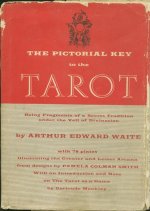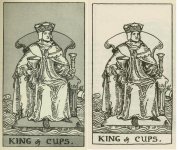Hello, here's the "1959/1960" First Edition Preface
The emphasis from University Press is that they have a four-color edition of the cards in the book and two textual notes.
The text as follows (beginning):
Publisher's Preface
THE TAROT cards now offered to us are beautiful, exact replicas, in four sumptuous colors, of the original colors of the original Waite-Smith cards. Even more remarkable, we now have for the first time what even Waite was unable to provide for us in his own lifetime: an edition of THE PICTORIAL KEY TO THE TAROT in which all 78 cards are reproduced in four colors! To the best of our knowledge, this is the first time in modern times that a complete deck of Tarot cards has been reproduced in a book (italics) in full color.
Two points of importance, not dealt with in Gertrude Moakley's Introduction, must now be discussed.
First, don't be misled by his quite arbitrary opposing of "occult" to "mystical". Most of us will agree with Waite in rejecting his predecessors' silly interpretation of the Tarot; but it was quite arbitrary of him to call these errors "occult" and to call the true interpretation "mystical." There is no real warrant for opposing these words to each other.
Second, one must take with a very large grain of salt Waite's insistance that Tarot cards have no history prior to the fourteenth century. If you read carefully enough Waite's own words, it becomes clear that his main purpose in dealing with the history of the Tarot is to put an end, once and for all, to the myth that is of Egyptian origin. That also serves him in discrediting the use of the Tarot for fortune-telling and divination. But as a repository of Secret Doctrine, and this is what he believed to be the deeper meaning of the Tarot, Waite himself actually believed that the Tarot goes back to at least as far as the Kabbalah--and this of course brings us deep into Hebrew antiquities. Note, for example, what Waite says of a number of Trumps Major: the High Priestess' "truest and highest name is Shekinah," and note that this Priestess bears in her lap the Torah (only the last letter is not showing). This, too, is why Major Trump X--Wheel of Fortune-- bears Hebrew letters.
And the Major XVII--The Star--is "in reality the Great Mother in the Kabbalistic Sephira Binah..." In a word, Waite's Tarot belongs to Kabbalah. No doubt, Waite's vows to the Golden Dawn prevented him from saying it as we do, but most important, he has given in his book a completely Kabbalistic interpretation of the Tarot. Perhaps even more to the point, is this Kabbalistic interpretation which you will see pictured in the Waite-Smith Tarot cards, and which you can now have for your own in the original full colors.
(End)
-------------------------------------------------------------------
(I probably will not be able to reproduce the whole text of the front and back flap of this 1959 edition, but there is repetition this is the first time the 78 cards were printed in full color in a book...then comes a tribute to Waite's wisdom, PCS' artistry, and how one should study the trumps for Kabbalistic symbolism. This is the final three paragraphs of the back flap:
Back flap text:
From 1959 Edition Cover
"Continued from Front Flap
...
magical Order of the Golden Dawn, and conveyed to the Order's members the secret tradition taught by the ancient mysteries. Arthur Edward Waite was a profound student of magic, theosophy, occultism, alchemy, the Rosacrucians, the Holy Grail, the Kabbalah, freemasonry. He found in all of them the same central theme: Man has suffered a great loss, and his heart is plagued with a longing to recover the lost treasure. Arthur Edward Waite found his way to the lost treasure. all who knew him testify that he was able to take a childlike, ecstatic delight in the simplest experiences of life. Everywhere he left an impression of grace and charm. His leonine head, lively dark eyes and majestic bearing did full justice to any ceremony, and he could recite the words as one who had full knowledge of the truths which they expressed.
Waite saw that Pamela Colman Smith, with her clairvoyance, her imagination, and her artistic competence, was just the right person to produce, under his guidance, a Tarot which would be at once a work of art and a gateway to truth. Waite's knowledge and wisdom provided the meaning.
Waite dwells long and lovingly on each of the twenty-two Trumps Major. these, are, of course, the cards which gives the Tarot its mysterious fascination. Waite's vows to the Order of the Golden Dawn prevented him from saying as plainly as we can that the tarot goes back to the Kabbalah--deep into Hebrew antiquities. If you will study carefully the Trumps Major, as well Waite's interpretations, you will see that in the most important pictures, the names or the symbols come to us from the Kabbalah. this is why Waite is at such points to refute the popular idea that the Tarot comes from Egypt. As long as we look in wrong direction, we shall wander away from the gateway of the truth. Arthur Edwards Waite's enduring contribution is that he has brought us to the gateway that Pamela Colman Smith has so beautifully depicted for us."
Cerulean's note/question:
(Maybe because this tarot information was not widely circulated or color printed in the U.S. in 1960, this book's claim to fame might be the 'color printing' as noteworthy new material? Although by 2009 standards, the bright comic-book color might remind us of RWS printing editions we prefer to have left behind.)
Hope that information helps.
Cerulean



